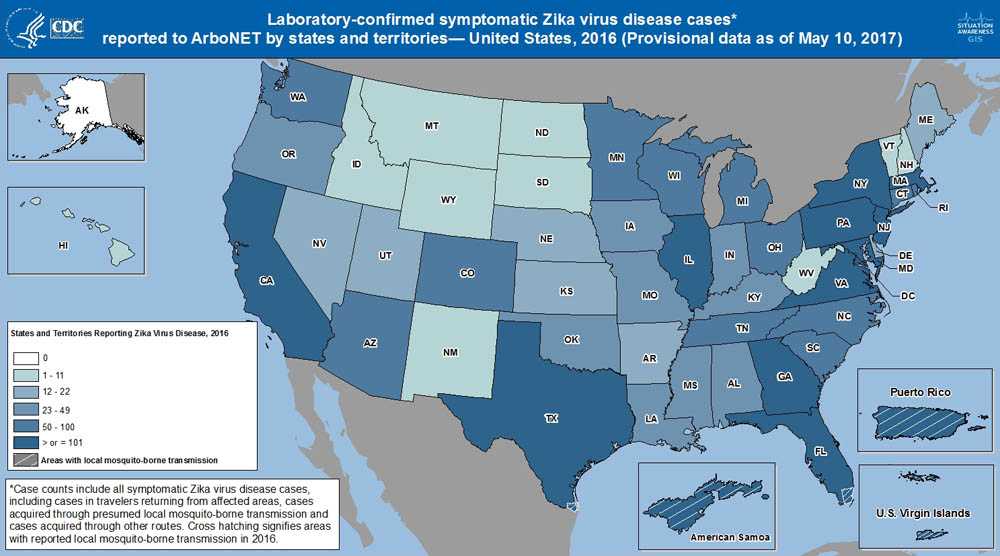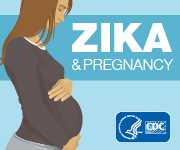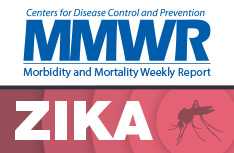2016 Case Counts in the US
Provisional Data* as of May 10, 2017
In 2016, Zika virus disease became a nationally notifiable condition. Cases are reported to CDC by state, territorial, and local health departments using standard case definitions. This web page contains provisional data reported to ArboNET for 2016.
US States
- 5,102 symptomatic Zika virus disease cases reported†
- 4,830 cases in travelers returning from affected areas
- 224 cases acquired through presumed local mosquito-borne transmission in Florida (N=218) and Texas (N=6)
- 48 cases acquired through other routes, including sexual transmission (N=46), laboratory transmission (N=1), and person-to-person through an unknown route (N=1)
US Territories
- 36,079 symptomatic Zika virus disease cases reported†
- 142 cases in travelers returning from affected areas
- 35,937 cases acquired through presumed local mosquito-borne transmission
- 0 cases acquired through other routes‡
Footnotes
*Data are provisional and might not reflect the actual number of Zika virus disease cases due to delays in reporting.
†Excludes congenital disease cases. Data reported to the US Zika Pregnancy Registry for outcomes of pregnancies with laboratory evidence of possible Zika virus infection in the United States is available on Outcomes of Pregnancies with Laboratory Evidence of Possible Zika Virus Infection in the United States.
‡Sexually transmitted cases are not reported for US territories because with local transmission of Zika virus it is not possible to determine whether infection occurred due to mosquito-borne or sexual transmission.
Cases by State and Territory

| Laboratory-confirmed symptomatic Zika virus disease cases and presumptive viremic blood donors reported to ArboNET by states and territories— United States, 2016 (Provisional data as of May 10, 2017) | ||||
|---|---|---|---|---|
|
Symptomatic disease cases*
(N=5,102) |
Presumptive viremic blood donors†
(N=37) |
|||
| States | No. | (%) | No. | (%) |
| Alabama | 37 | (1) | 0 | (0) |
| Arizona | 54 | (1) | 1 | (3) |
| Arkansas | 13 | (<1) | 0 | (0) |
| California | 421 | (8) | 4 | (11) |
| Colorado | 55 | (1) | 0 | (0) |
| Connecticut | 58 | (1) | 0 | (0) |
| Delaware | 17 | (<1) | 0 | (0) |
| District of Columbia | 39 | (1) | 0 | (0) |
| Florida‡ | 1,115 | (22) | 23 | (62) |
| Georgia | 107 | (2) | 0 | (0) |
| Hawaii | 11 | (<1) | 0 | (0) |
| Idaho | 4 | (<1) | 0 | (0) |
| Illinois | 103 | (2) | 0 | (0) |
| Indiana | 49 | (1) | 0 | (0) |
| Iowa | 26 | (1) | 1 | (3) |
| Kansas | 20 | (<1) | 0 | (0) |
| Kentucky | 32 | (1) | 0 | (0) |
| Louisiana | 38 | (1) | 0 | (0) |
| Maine | 12 | (<1) | 0 | (0) |
| Maryland | 130 | (3) | 0 | (0) |
| Massachusetts | 118 | (2) | 1 | (3) |
| Michigan | 67 | (1) | 0 | (0) |
| Minnesota | 67 | (1) | 0 | (0) |
| Mississippi | 23 | (<1) | 0 | (0) |
| Missouri | 35 | (1) | 0 | (0) |
| Montana | 9 | (<1) | 0 | (0) |
| Nebraska | 13 | (<1) | 0 | (0) |
| Nevada | 22 | (<1) | 1 | (3) |
| New Hampshire | 11 | (<1) | 0 | (0) |
| New Jersey | 180 | (4) | 0 | (0) |
| New Mexico | 10 | (<1) | 0 | (0) |
| New York | 1,001 | (20) | 2 | (5) |
| North Carolina | 97 | (2) | 0 | (0) |
| North Dakota | 3 | (<1) | 0 | (0) |
| Ohio | 83 | (2) | 0 | (0) |
| Oklahoma | 29 | (1) | 0 | (0) |
| Oregon | 47 | (1) | 0 | (0) |
| Pennsylvania | 175 | (3) | 0 | (0) |
| Rhode Island | 54 | (1) | 0 | (0) |
| South Carolina | 59 | (1) | 0 | (0) |
| South Dakota | 3 | (<1) | 0 | (0) |
| Tennessee | 61 | (1) | 0 | (0) |
| Texas‡ | 312 | (6) | 4 | (11) |
| Utah | 21 | (<1) | 0 | (0) |
| Vermont | 11 | (<1) | 0 | (0) |
| Virginia | 108 | (2) | 0 | (0) |
| Washington | 69 | (1) | 0 | (0) |
| West Virginia | 11 | (<1) | 0 | (0) |
| Wisconsin | 60 | (1) | 0 | (0) |
| Wyoming | 2 | (<1) | 0 | (0) |
|
Symptomatic disease cases*
(N=36,079) |
Presumptive viremic blood donors†
(N=322) |
|||
| Territories | No. | (%) | No. | (%) |
| American Samoa | 129 | (<1) | 0 | (0) |
| Puerto Rico | 34,963 | (97) | 322 | (100) |
| U.S. Virgin Islands | 987 | (3) | 0 | (0) |
Footnotes
*Includes reported confirmed and probable Zika virus disease cases per the CSTE case definitions.
† Presumptive viremic blood donors are people who reported no symptoms at the time of donating blood, but whose blood tested positive when screened for the presence of Zika virus RNA by the blood collection agency. Some presumptive viremic blood donors develop symptoms after their donation or may have had symptoms in the past. These individuals may be reported as both Zika virus disease cases and presumptive viremic blood donors.
‡Includes 218 cases in Florida and 6 cases in Texas that were acquired through presumed local mosquito-borne transmission.
- Page last reviewed: October 12, 2017
- Page last updated: October 12, 2017
- Content source:





 ShareCompartir
ShareCompartir